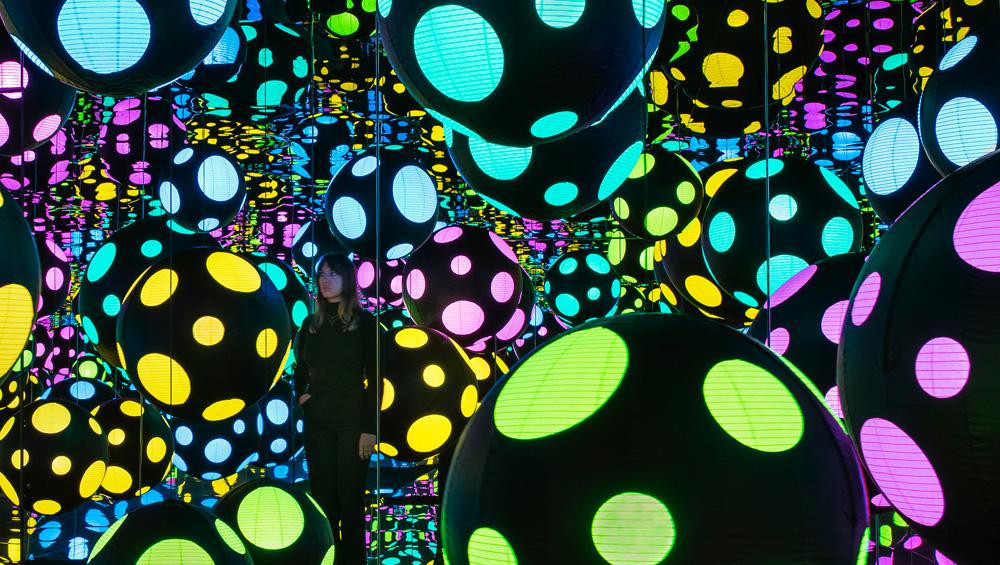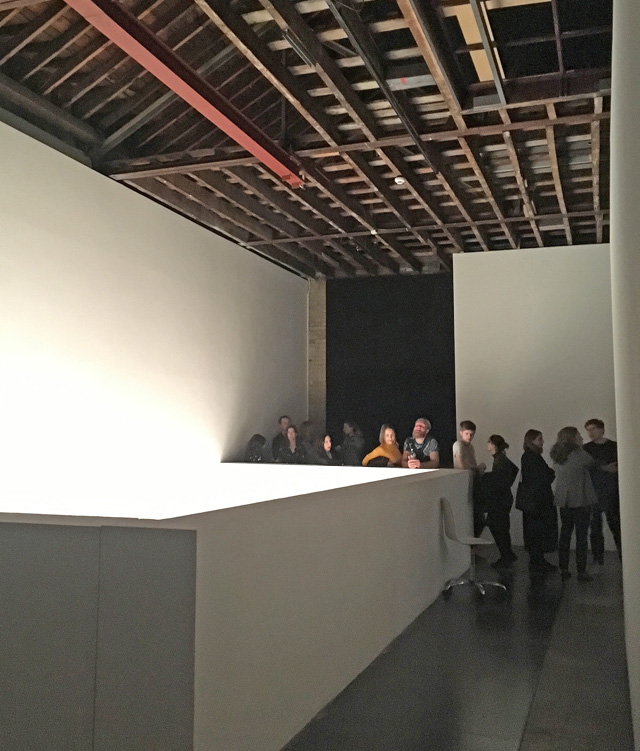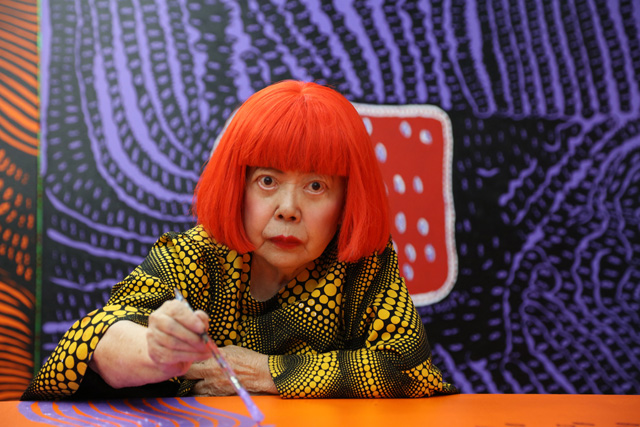
Yayoi Kusama. INFINITY MIRRORED ROOM - MY HEART IS DANCING INTO THE UNIVERSE, 2018. © Yayoi Kusama. Courtesy Ota Fine Arts, Tokyo / Singapore / Shanghai and Victoria Miro, London / Venice.
Victoria Miro Gallery, London
3 October - 21 December 2018
by VERONICA SIMPSON
“Museums today are all about entertainment,” declared US artist Dan Graham, in a recent interview with Studio International. On many levels, Yayoi Kusama’s latest exhibition at the Victoria Miro Gallery, London, would appear to back up his theory. The hype started even before the exhibition opened: the buildup of hysteria on social media to book your experience in the artist’s Infinity Mirror Room before the timed slots sold out; then the silliness of having to queue for more than half an hour to be allowed your allotted one-minute walk around the work’s simple box structure, its interior covered in mirrors and filled with illuminated polka-dot lanterns; the warnings that you might find the experience “disorienting”. It all comes across as so much PR hoopla, fuelled more by the artist’s status as No 1 Instagram sensation than any profound estimation of her work’s worth.

Queue for Yayoi Kusama's Infinity Mirrored Room at Victoria Miro, London, 2018. Photo: Veronica Simpson.
Yet it is hard to begrudge this 89-year-old Japanese artist (b1929, Matsumoto City), who has famously struggled since childhood with mental health issues, her (extended) moment in the limelight. In the past five years, more than five million visitors have apparently queued for a peek at her work; for a recent show at The Broad in Los Angeles, 90,000 $25 tickets sold out in one afternoon. As others have noted, it took the age of the selfie to whisk Kusama out of the relative obscurity she had endured since her early notoriety in the 1960s as a performance artist and the creator of nude and body-painting “happenings” in New York.
.jpg)
Yayoi Kusama. INFINITY MIRRORED ROOM - MY HEART IS DANCING INTO THE UNIVERSE, 2018. Wood and glass mirror room with paper lanterns, 304 x 622.4 x 622.4 cm (119 5/8 x 245 1/8 x 245 1/8 in). © Yayoi Kusama. Courtesy Ota Fine Arts, Tokyo / Singapore / Shanghai and Victoria Miro, London / Venice.
By the end of the 60s, she ranked alongside Andy Warhol and Claes Oldenburg (who seemingly borrowed her ideas, the former for painted wallpaper, the latter from her soft sculptures). Her star certainly waned for the three decades after her return to Japan in the 70s, when she voluntarily admitted herself to a Tokyo psychiatric institution. But she has doggedly pursued her unique, hallucinatory practice in her studio just across the road; and with a retrospective at the New York’s Center for International Contemporary Arts in 1989, her artistic rehabilitation began, followed by selection to represent Japan at the Venice Biennale in 1993, then a retrospective at Tate Modern in London in 2012.

Yayoi Kunama. Courtesy Ota Fine Arts, Tokyo / Singapore / Shanghai and Victoria Miro, London / Venice. © Yayoi Kusama.
Fame is apparently something she craved in young adulthood, her ambition so great that she once wrote: “I am determined to create Kusama world.” With the opening of her dedicated gallery in Tokyo last year, she pretty much has. And she has wealth - The Infinity Room is estimated to have a sale price of between $1m and $2m. The giant bronze pumpkins, also present in this exhibition, are estimated to be valued at $1.5m each.
So, it would be easy to be cynical. First, at the willingness of her collectors and gallerists to exploit this fragile artist’s frenetic output for maximum material gain (does quality control even come into it when the price tags are so high?). Second, at the punters madly mugging at their smartphone cameras – even lifting up their infants for Kusama-assisted Insta-immortalisation – in every photogenic spot throughout this exhibition; the heart sinks at the thought of the same self-aggrandising silliness being pursued at all the other Kusama spectaculars that are still parading, like some West End theatrical phenomenon to be milked of every profitable drop, around the globe.
-b.jpg)
Yayoi Kusama. GARDEN OF WOMEN IN BLOOMING YOUTH, 2018. Acrylic on canvas, 194 x 194 cm (76 3/8 x 76 3/8 in). © Yayoi Kusama. Courtesy Ota Fine Arts, Tokyo / Singapore / Shanghai and Victoria Miro, London / Venice.
A minority of her millions of visitors will be aware of Kusama’s pioneering role as a young female artist: always an outsider in 60s New York, for her gender and her nationality, she ploughed her own furrow, flirting with pop art, abstract expressionism, with surrealism and minimalism, but always on her own terms. What about the vast majority? Do they come purely for Insta-gratification, a little easy-on-the-eye cultural kudos? Or is it the simple Teletubby appeal of her giant, colourful, oversized plants? Is it empathy with her life story? At a Q&A with the film director Heather Lenz after a screening of Lenz’s impressive new documentary, Kusama: Infinity, it was clear that few in the audience had known Kusama lived in a psychiatric hospital. But there was, of course, sympathy and understanding for the outlet that art has provided her.
She says in the film: “I fight pain, anxiety and fear every day, and the only method I have found that relieves my illness is to keep creating art. I followed the thread of art and somehow discovered a path that would allow me to live.”
-a-(1).jpg)
Yayoi Kusama, installation view, THE MOVING MOMENT WHEN I WENT TO THE UNIVERSE, Victoria Miro, Wharf Road, London 3 October - 21 December 2018. © Yayoi Kusama. Courtesy Ota Fine Arts, Tokyo / Singapore / Shanghai and Victoria Miro, London / Venice.
This show features all new work, but the themes are, for the most part, ones that Kusama has visited before. The Infinity Mirror Room is no more than the sum of its parts; if you want to experience a really provocative and original Kusama mirror work, go to see her ground-breaking Narcissus Garden (1966), now on show at the Hayward Gallery’s Space Shifters exhibition. Setting that selfie-sideshow apart, it is pumpkins that dominate the offer here. She said (in her 2011 book Infinity Net: the Autobiography of Yayoi Kusama) that she loves these plants for their “generous unpretentiousness”, and “solid spiritual balance”. The sculptures are certainly solid and grounding, weighed down by their bronze immensity, yet so glossily rendered in red, yellow or green, that they could be mistaken for ceramics. For me, however, they lack poetry. They have the slightly comic appeal of a scaled-up garden gnome. The paintings surrounding these sculptures are variations on a pumpkin theme, with plants either in profile or closeup, featuring intense, tapering lines of black dots, in the same red, green and yellow tones.
![Yayoi Kusama. PUMPKIN [WUTIU], 2018. Acrylic on canvas, 100 x 100 cm (39 3/8 x 39 3/8 in). © Yayoi Kusama. Courtesy Ota Fine Arts, Tokyo / Singapore / Shanghai and Victoria Miro, London / Venice.](/images/articles/k/083-kusama-yayoi-2018/KUSA1143_PUMPKIN-[WUTIU]_2018-(Jack-Hems)-b.jpg)
Yayoi Kusama. PUMPKIN [WUTIU], 2018. Acrylic on canvas, 100 x 100 cm (39 3/8 x 39 3/8 in). © Yayoi Kusama. Courtesy Ota Fine Arts, Tokyo / Singapore / Shanghai and Victoria Miro, London / Venice.
The closeups certainly are mesmerising, compelling in their op art effects. Stand too near and there is a sense of being sucked into their multidimensional, pulsating visual fields. Does this in any way replicate the hallucinatory effects that Kusama has spoken of when she communes with nature? Kusama’s wealthy but dysfunctional family grew violets, peonies and pumpkins in huge plant nurseries to sell all over Japan. She claims she took her sketchbook to the flowerbeds from a young age, which is where she first experienced the impression that the plants were speaking to her; after that, whenever she experienced altered visual or auditory states, she rushed to pin down this experience in paint or crayon.
-b-(1).jpg)
Yayoi Kusama, installation view, FLOWERS THAT SPEAK ALL ABOUT MY HEART GIVEN TO THE SKY, 2018, Victoria Miro, Wharf Road, London 3 October - 21 December 2018. © Yayoi Kusama. Courtesy Ota Fine Arts, Tokyo / Singapore / Shanghai and Victoria Miro, London / Venice.
There are more oversized sculptures in the gallery’s waterside garden: painted bronze flowers, caught somewhere “between nature and exuberant artifice”, says the gallery publicity. They are definitely fantastical. Called Flowers That Speak All About My Heart Given to the Sky (2018), the euphoric note in their title is continued in the paintings we see upstairs back in the gallery – a series Kusama has called My Eternal Soul. Measuring 2 sq metres and clustered along one wall, there is something eternal and primal about them pre-conscious, reminiscent of dreamtime depictions and figurations from indigenous Australian art, filled with intense repetitions of organic symbols, from seeds to petals to eyes.
But I am still unsure whether I like these works the most because they are the least Instagrammable of all. The price of fame …